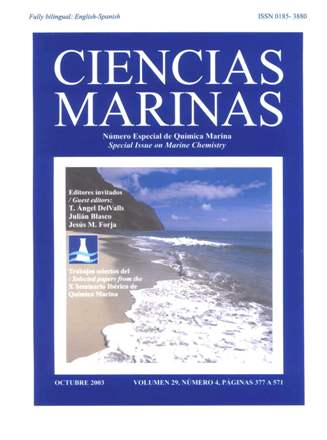Nutrient dynamics in a coastal lagoon (Ria Formosa, Portugal): The importance of lagoon–sea water exchanges on the biological productivity
Main Article Content
Abstract
Silicates, nitrates, phosphates, chlorophyll a and primary productivity were monitored at low and high tide between September 1985 and September 1986, at four stations in Ria Formosa, a meso-tidal coastal lagoon located in the south of Portugal. The water sampling and the in situ observations were done alternatively in neap and spring tide. While silicates at low tide exceeded values at high tide thorughout the year and a weak seasonal trend was discerned, nitrates and phosphates exhibited a clear-cut seasonal variation at high spring tide. Pronounced maxima in the period of low temperatures (early spring), 7 µM of nitrates and 3 µM of phosphates, indicate their import from the adjacent coastal zone. Lower values at low tide and chlorophyll a increases (up to 2 µg g–1) point to a rapid biological consumption of the imported nutrients. Differences of temperature between coastal waters and those of the lagoon in early spring account for the more efficient consumption by the primary producers of the lagoon. The primary productivity varied from 2 mg C m–3 h–1 (winter) to 30 mg C m–3 h–1 (summer), reflecting the intensive 14C incorporation during the warmer period. High rates of nitrates and phosphates consumption could be observed during spring, when their concentrations decreased 50% within a narrow period of 6 hours from high to low tide.
Downloads
Article Details
This is an open access article distributed under a Creative Commons Attribution 4.0 License, which allows you to share and adapt the work, as long as you give appropriate credit to the original author(s) and the source, provide a link to the Creative Commons license, and indicate if changes were made. Figures, tables and other elements in the article are included in the article’s CC BY 4.0 license, unless otherwise indicated. The journal title is protected by copyrights and not subject to this license. Full license deed can be viewed here.

